Respiratory Anatomy of the Dogfish Shark
Examine the photographs of the gill pouches of the spiny
dogfish shark by clicking the blue lettered links in the column to the right.
The specimen in the photograph was prepared by cutting across the gill slits
from the pectoral girdle to the corner of the mouth. It was cut across the
ventral musculature to lay the entire preparation flat.
The gills are the respiratory organs of the shark. They
are composed of gill lamellae, blood vessels, and supporting cartilaginous
structures are are located in a series of pharyngeal pouches. |
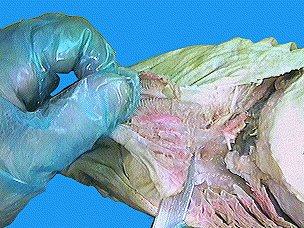
Shark Gill Pouches
Labeled Gill Pouches
|
|
Examine the photographs of the inside of the oral and pharyngeal
cavities of the spiny dogfish shark by clicking the blue lettered links
in the column to the right.
The oral cavity is the area enclosed by the jaws (mandibular
arch) and the cartilage of the throat (hyoid arch).
The triangular sharp teeth are arranged in several rows
beginning at the outer edges of the upper and lower jaws. Behind the functional
teeth are additional rows folded downward ready to replace any that are
lost.
The tongue of the shark is practically immovable and without
muscles. It is supported anteriorly and posteriorly by cartilage.
The pharynx is the portion of the alimentary canal posterior
to the hyoid arch between the gills. Posteriorly it narrows to form the
esophagus.
The spiracles are openings in the anterior roof of the
pharynx. The shark can bring water into its pharynx to the gills by way
of the spiracle and mouth. |
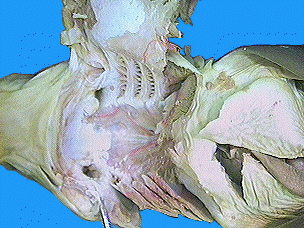
Shark Pharyngeal Cavity
Labeled Pharyngeal Cavity
|
|
Examine the bottom view photographs of the shark's pharynx
and heart by clicking the blue lettered links in the column to the right.
The gills are provided with a rich blood supply. Arteries
run directly from the nearby heart to the gills bringing deoxygenated blood
into the gill lamellae. Oxygen diffuses from the ventilating water current
flowing over the gills into the blood. |
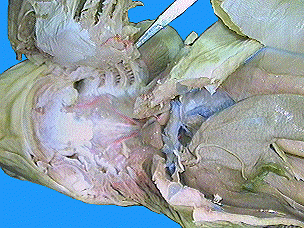
Shark Heart & Gills
Labeled Heart & Gills
|
|
Examine the photographs of the shark's internal gill slits
by clicking the blue lettered links in the column to the right.
As you look at the pharynx you will see five internal gill
slits. They lead into cavities called gill pouches, which lead to the outside
by external gill slits.
The gill slits are supported by cartilaginous gill arches
and guarded by small cartilaginous papillae-like gill rakers which act as
strainers to prevent food particles from leaving the pharynx through the
gill slits. |
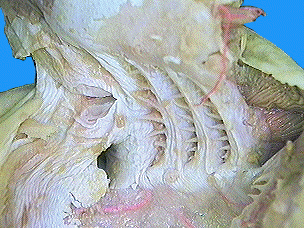
Shark Gill Rakers
Labeled Gill Rakers
|
|
Examine the photographs of the shark's gill pouch by clicking
the blue lettered links in the column to the right.
The partitions between gill pouches are referred as branchial
bars.
The gill lamellae on one side of a branchial bar are called
a demibranch, or half gill.
The demibranchs on the anterior and posterior surface of
a single branchial bar are termed a holobranch, or complete gill. Thus,
one holobranch belongs to two different gill pouches; the anterior half
(demibranch) to the anterior gill pouch, the posterior gill demibranch to
the posterior gill pouch. |
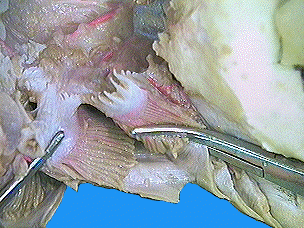
Shark Gill Arches
Labeled Gill Arches
|
|
Examine the photographs of the shark's gill lamellae by
clicking the blue lettered links in the column to the right.
The Gill Lamellae are radially folded, highly vascularized
tissue attached to the surface of a tough connective tissue, the interbranchial
septum.
Each septum is attached medially to a portion of the cartilaginous
gill arch.
The superficial constrictor muscles act as flap-like valves
to open and close the external gill slits. |
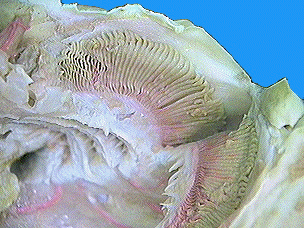
Shark Gill Lamellae
Labeled Gill Lamellae
|